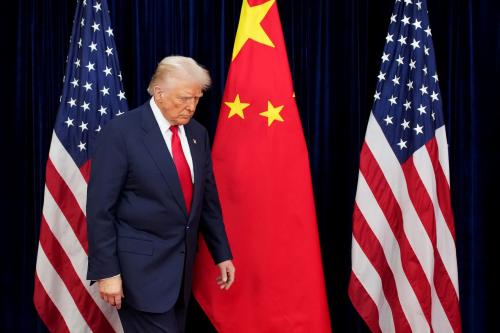Yesterday’s blog—“Presidents, Nuclear Reductions and the Senate”—described how presidents over the past 40 years have sought to limit or reduce nuclear weapons by means other than a treaty requiring two-thirds majority approval in the Senate. Why would the Obama administration consider something other than a treaty? Because it fears that Republicans in the Senate would not consider a treaty on its merits. A comparison of the ratification experiences of the Strategic Offensive Reductions Treaty (SORT) signed by President George W. Bush in 2002 and the New Strategic Arms Reduction Treaty (New START) signed by Mr. Obama in 2010 provides Exhibit A for those fears.
SORT limited the United States and Russia each to no more than 1,700-2,200 “strategic nuclear warheads,” the level of nuclear weapons that the Bush administration’s 2001 nuclear posture review concluded was necessary for the United States—regardless of what levels of nuclear arms other countries had. Mr. Bush originally proposed that he and President Vladimir Putin merely make statements of national policy setting out their intended strategic force levels, but he later agreed to do a treaty at Mr. Putin’s insistence.
SORT was not much of a treaty. While START I and New START each made a good-sized book, SORT barely filled two pages. Curiously, it did not define a “strategic nuclear warhead” … or any other term for that matter. Lacking any monitoring provisions, SORT was unverifiable.
It appears, moreover, that Washington and Moscow did not even count the same weapons. The Bush administration defined “strategic nuclear warheads” as the same as “operationally deployed strategic nuclear warheads”—that is, nuclear warheads on intercontinental ballistic missiles (ICBMs) and submarine-launched ballistic missiles (SLBMs) plus nuclear bombs and air-launched cruise missiles stored at air bases for B-2 and B-52 bombers (as a normal practice, neither side’s air force keeps weapons on bombers). The Russians, however, apparently tallied only warheads on ICBMs and SLBMs. They did not count bombs or air-launched cruise missiles at air bases for their bombers; those weapons were not on the aircraft and thus not “deployed.”
On March 6, 2003, 48 Republican senators voted to consent to ratify SORT, which won approval by a tally of 95-0.
Given how SORT sailed through the Senate, the Obama administration in 2010 expected the New START Treaty to receive easy approval as well. After all, the treaties imposed similar limits on deployed strategic warheads. New START specified a limit of 1,550, but it treated each bomber as only one deployed warhead (bombers can carry more). The United States and Russia each likely have 200-300 additional weapons to put on their bombers, so New START’s 1,550 limit amounts to about 1,800 or so total weapons, equivalent to SORT’s 1,700-2,200. In contrast to SORT, the sides use agreed counting rules under New START, so they count the same things. Moreover, New START has substantial monitoring provisions and is verifiable.
What happened to New START in the Senate? It faced a tortuous ratification debate: myriad claims of alleged flaws and weaknesses, 1,000 questions for the record, and several efforts to delay a vote. On December 22, 2010, the Senate finally approved New START by a count of 71-26. Seventy-one votes meant four more than needed, but it was a far cry from the 95 votes that approved SORT.
The 26 senators who voted against New START in 2010 were all Republicans. Sixteen of them held seats in the Senate in 2003; 15 voted to approve SORT while one abstained. Moreover, three other Republican senators who voted to approve SORT chose to abstain on New START.
So 18 Republican senators who voted “yea” on SORT in 2003 just seven years later found New START—a verifiable treaty with agreed counting rules and a warhead limit comparable to SORT—an unacceptable risk to U.S. national security. One can be forgiven for thinking that factors other than New START’s merits and the national interest figured in their votes. Indeed, one senator attributed his “nay” vote against New START to unhappiness with the Obama administration’s decision to do away with the military’s “don’t ask/don’t tell” policy.
It thus should come as little surprise that the Obama administration thinks about arrangements other than a treaty. And the administration need only look back to its predecessor for a ready model: the Bush administration’s original proposal in 2001 that Mr. Bush and Mr. Putin simply make parallel statements of the number of strategic warheads that each country would deploy.
Say that Mr. Obama and Mr. Putin now agree that they could reduce the number of each country’s deployed strategic warheads from New START’s limit of 1,550 to 1,000 (still well more than enough to devastate the other). The two presidents could announce, perhaps in a joint statement, that each had decided as a matter of national policy to limit his country’s strategic forces to no more than 1,000 deployed strategic warheads.
The 1,000 limit would be politically binding, while the 1,550 limit would remain a legally binding constraint. U.S. and Russian officials could use the detailed monitoring provisions of New START to verify compliance with both limits.
This would be a relatively fast and simple way to achieve further nuclear reductions—not requiring a new treaty, not requiring a treaty amendment, and not requiring a vote in the Senate.
To be clear, the preferable way for such an arms control agreement would be a legally binding treaty, ideally one that limited all U.S. and Russia nuclear weapons, not just deployed strategic warheads. But a treaty is not the only option the Obama administration has. Nor, given attitudes of some in the Republican Senate ranks, is it the only option the administration should consider.
The Brookings Institution is committed to quality, independence, and impact.
We are supported by a diverse array of funders. In line with our values and policies, each Brookings publication represents the sole views of its author(s).



Commentary
SORT vs. New START: Why the Administration is Leery of a Treaty
March 15, 2013